Comparo: 2013 Subaru BRZ versus 2011 Subaru WRX STI
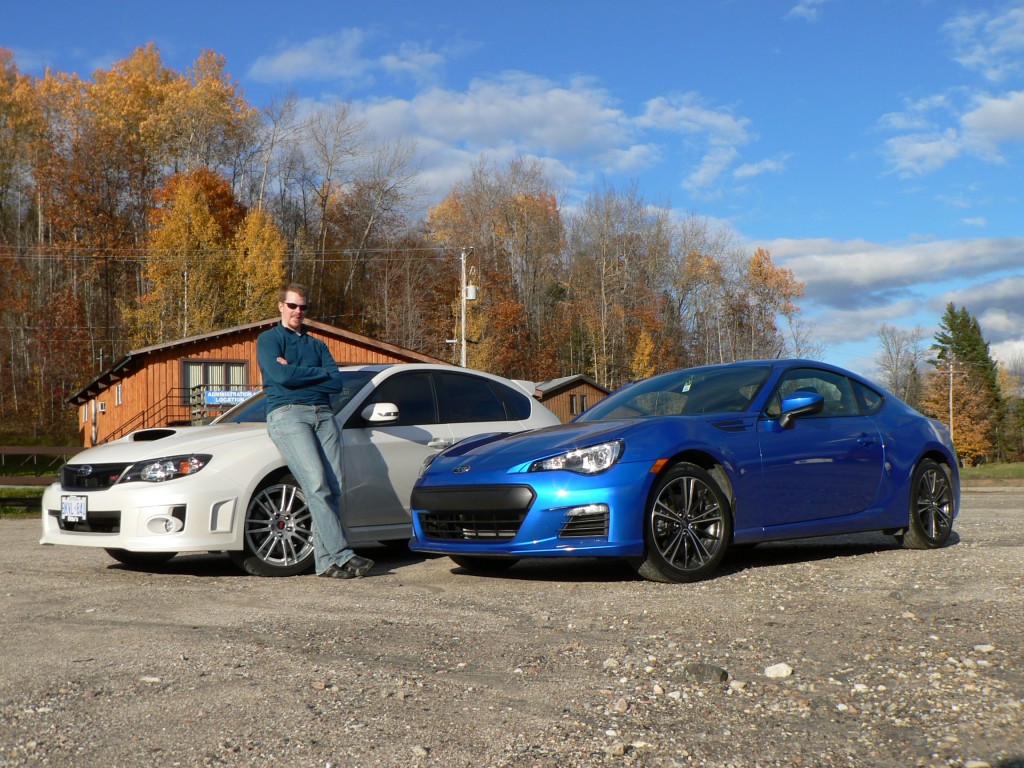 Story and photos by John LeBlanc
OTTAWA - Let’s be frank, with its multiple World Rally Championship-winning WRX models firmly established with driving enthusiasts for decades now, Subaru doesn’t need the new-for-2013 BRZ to buff up its performance image. So how did the Japanese automaker — a company best known for making turbocharged all-wheel-drive wagons and sedans — end up with a naturally aspirated rear-wheel-drive sports car?
For that, you can thank Toyota. Wanting to prove to the world it’s capable of producing more than just appliance-like Corollas and Camrys, it enlisted Subaru (of which it part owns) to help out on a sports car project, sold as the Scion FR-S and Subaru BRZ in Canada.
Subaru’s engineers handled the majority of the car’s development, supplying the engine, creating the chassis and building the car. Toyota looked after the styling (except for the badges, and subtle changes to the front and rear fascias, the cars are virtually identical outside and in) and added its eight-injector direct and port fuel injection hardware to Subaru’s naturally aspirated 2.0-litre flat-four engine.Regardless of its heritage, the new Subaru BRZ will take some customers back in time. Its minimalist form and reasonable price (well-equipped models start at $27,295), brings to mind 1980s Japanese sports cars. While some may cite Mazda’s MX-5, Hyundai’s Genesis Coupe or Ford’s V6 Mustang as current competition, arguably, except for its near-identical twin, there’s really nothing on the market today that matches the new BRZ’s pure driving pleasure/price ratio.
Story and photos by John LeBlanc
OTTAWA - Let’s be frank, with its multiple World Rally Championship-winning WRX models firmly established with driving enthusiasts for decades now, Subaru doesn’t need the new-for-2013 BRZ to buff up its performance image. So how did the Japanese automaker — a company best known for making turbocharged all-wheel-drive wagons and sedans — end up with a naturally aspirated rear-wheel-drive sports car?
For that, you can thank Toyota. Wanting to prove to the world it’s capable of producing more than just appliance-like Corollas and Camrys, it enlisted Subaru (of which it part owns) to help out on a sports car project, sold as the Scion FR-S and Subaru BRZ in Canada.
Subaru’s engineers handled the majority of the car’s development, supplying the engine, creating the chassis and building the car. Toyota looked after the styling (except for the badges, and subtle changes to the front and rear fascias, the cars are virtually identical outside and in) and added its eight-injector direct and port fuel injection hardware to Subaru’s naturally aspirated 2.0-litre flat-four engine.Regardless of its heritage, the new Subaru BRZ will take some customers back in time. Its minimalist form and reasonable price (well-equipped models start at $27,295), brings to mind 1980s Japanese sports cars. While some may cite Mazda’s MX-5, Hyundai’s Genesis Coupe or Ford’s V6 Mustang as current competition, arguably, except for its near-identical twin, there’s really nothing on the market today that matches the new BRZ’s pure driving pleasure/price ratio.
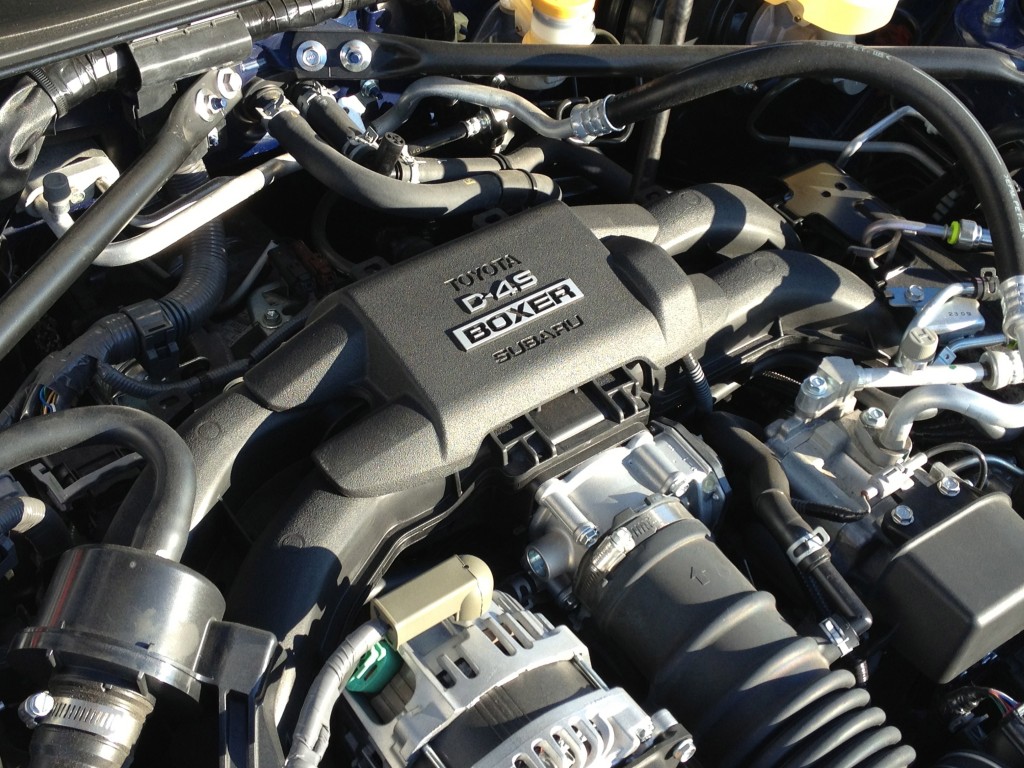 But the reason we’re gathered here today is it ask: Is the BRZ worthy of wearing Subaru’s Tri-Star badge? To find out, we asked Ottawa native and WRX STI hatchback owner Paul Stacey, (seen above) for his thoughts on the new Subaru sports car. A life-long driving enthusiast, Stacey is the type of customer Subaru wants to keep happy. His current STI is his third WRX. He started with the first models that arrived in Canada in 2002, and then moved up to a 2011 WRX. But that wasn’t, well, enough.“So I traded up for my current WRX STI,” says Stacey. And this enthusiast’s rides aren’t garage queens. Stacey raced his first ‘Rex in the grueling Targa Newfoundland road rally race, and frequents the nearby Calabogie Motorsports with his current STI for the occasional lapping day.
The main reason the Subaru flat-four mill was chosen was to keep the BRZ’s centre of gravity as low as possible — at just over 46 centimetres, it’s lower than a Porsche Cayman. And compared to his more upright, Impreza-based WRX STI, the low seating position is the first thing Stacey notices when dropping his over-six-foot frame into the BRZ’s cosy cabin. Even when compared to a similarly priced Impreza, the BRZ’s interior uses less-expensive-feeling plastics and trim. For instance, the climate controls are straight from a Toyota Yaris, and they feel just as toy-like here. At least the parts the driver engages with on a regular basis —seats, steering wheel and gear-shifter — are driver-oriented bits of kit. Stacy also noticed the lack of driver instrumentation. The dash is very minimalist.
But the reason we’re gathered here today is it ask: Is the BRZ worthy of wearing Subaru’s Tri-Star badge? To find out, we asked Ottawa native and WRX STI hatchback owner Paul Stacey, (seen above) for his thoughts on the new Subaru sports car. A life-long driving enthusiast, Stacey is the type of customer Subaru wants to keep happy. His current STI is his third WRX. He started with the first models that arrived in Canada in 2002, and then moved up to a 2011 WRX. But that wasn’t, well, enough.“So I traded up for my current WRX STI,” says Stacey. And this enthusiast’s rides aren’t garage queens. Stacey raced his first ‘Rex in the grueling Targa Newfoundland road rally race, and frequents the nearby Calabogie Motorsports with his current STI for the occasional lapping day.
The main reason the Subaru flat-four mill was chosen was to keep the BRZ’s centre of gravity as low as possible — at just over 46 centimetres, it’s lower than a Porsche Cayman. And compared to his more upright, Impreza-based WRX STI, the low seating position is the first thing Stacey notices when dropping his over-six-foot frame into the BRZ’s cosy cabin. Even when compared to a similarly priced Impreza, the BRZ’s interior uses less-expensive-feeling plastics and trim. For instance, the climate controls are straight from a Toyota Yaris, and they feel just as toy-like here. At least the parts the driver engages with on a regular basis —seats, steering wheel and gear-shifter — are driver-oriented bits of kit. Stacy also noticed the lack of driver instrumentation. The dash is very minimalist.
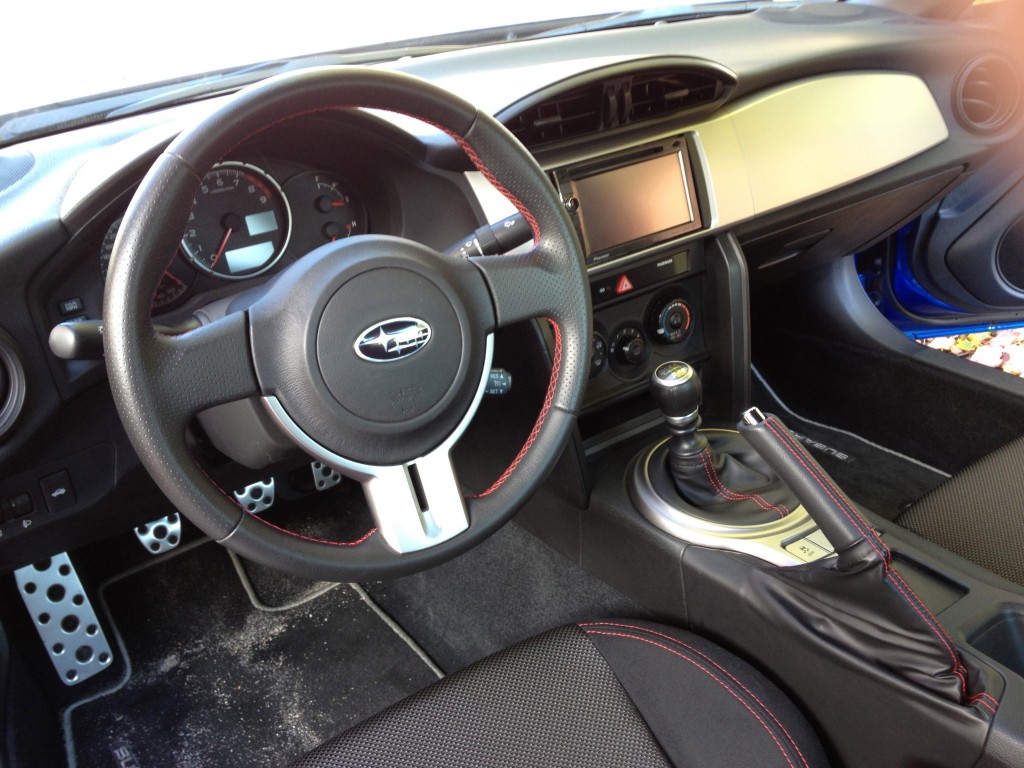 Although it looks like a hatchback, the BRZ has a small rear trunk. Its rear seats fold down, but the available cargo room is no match for the relatively cavernous STI hatch. I suspect the BRZ’s “+2” rear seats will rarely be used for human occupation. As Stacey commented, “I don’t know why they bothered to put the seats in the back.” I agree. Adjusted to a seating position for someone of average height, rear legroom virtually disappears.
The BRZ only weighs a featherlike 1,255 kilograms (more than a quarter ton less than a WRX), so a monster powerplant like that of the WRX is not a part of the present package. The BRZ’s four-cylinder only puts out 200 horsepower and 151 lb.-ft of torque, resulting in a 0-100 km/h time of 7.7 seconds. It’s nowhere near the blistering pace set by the 260-hp WRX (5.4 seconds), let alone the 305-hp WRX STI (4.9 seconds), but it’s competitive with competitively priced sports compacts.
“I would like to see more power,” says Stacey. While a turbocharged version of the BRZ’s existing flat-four making about 280 hp and more than 250 lb-ft. of torque has been rumoured, nothing's been given the green light yet.
Although it looks like a hatchback, the BRZ has a small rear trunk. Its rear seats fold down, but the available cargo room is no match for the relatively cavernous STI hatch. I suspect the BRZ’s “+2” rear seats will rarely be used for human occupation. As Stacey commented, “I don’t know why they bothered to put the seats in the back.” I agree. Adjusted to a seating position for someone of average height, rear legroom virtually disappears.
The BRZ only weighs a featherlike 1,255 kilograms (more than a quarter ton less than a WRX), so a monster powerplant like that of the WRX is not a part of the present package. The BRZ’s four-cylinder only puts out 200 horsepower and 151 lb.-ft of torque, resulting in a 0-100 km/h time of 7.7 seconds. It’s nowhere near the blistering pace set by the 260-hp WRX (5.4 seconds), let alone the 305-hp WRX STI (4.9 seconds), but it’s competitive with competitively priced sports compacts.
“I would like to see more power,” says Stacey. While a turbocharged version of the BRZ’s existing flat-four making about 280 hp and more than 250 lb-ft. of torque has been rumoured, nothing's been given the green light yet.
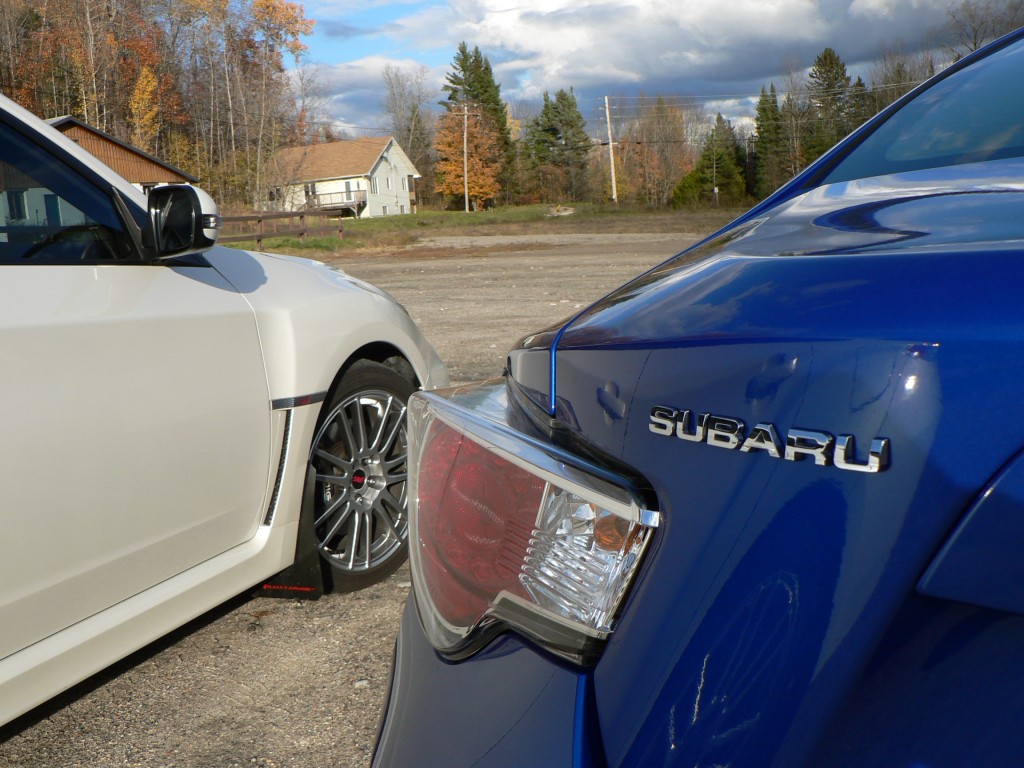 Perhaps the biggest difference between the BRZ and its Impreza-based mates is the way it goes down the road and around corners. Its small size and light weight, combined with direct feedback from the throttle, steering, and brakes makes the BRZ feel alert compared to Stacey’s bulky STI. With 215/45R17 tires (also used on the Toyota Prius) versus the STI’s 245/40R18 rubber, the BRZ certainly has less contact with the tarmac.Those used to all-wheel drive may find the BRZ’s rear-drive chassis takes some getting used to. Especially at the back of the sports car, where its skinny rubber loses grip quickly, but in a predictable and linear fashion. “Through some of these corners, I didn’t push the car all that hard all, but I felt the rear end push out quite easily,” Stacey added.
In something of a surprise, the STI edges out the BRZ in terms of ride quality. The coupe’s front MacPherson struts and double-wishbone rear are notably firmer. And while the STI is no Lexus, the BRZ’s cabin a lot noisier on the move. “If it’s going to be your only car, you might get a bit tired of it,” says Stacey.
Perhaps the biggest difference between the BRZ and its Impreza-based mates is the way it goes down the road and around corners. Its small size and light weight, combined with direct feedback from the throttle, steering, and brakes makes the BRZ feel alert compared to Stacey’s bulky STI. With 215/45R17 tires (also used on the Toyota Prius) versus the STI’s 245/40R18 rubber, the BRZ certainly has less contact with the tarmac.Those used to all-wheel drive may find the BRZ’s rear-drive chassis takes some getting used to. Especially at the back of the sports car, where its skinny rubber loses grip quickly, but in a predictable and linear fashion. “Through some of these corners, I didn’t push the car all that hard all, but I felt the rear end push out quite easily,” Stacey added.
In something of a surprise, the STI edges out the BRZ in terms of ride quality. The coupe’s front MacPherson struts and double-wishbone rear are notably firmer. And while the STI is no Lexus, the BRZ’s cabin a lot noisier on the move. “If it’s going to be your only car, you might get a bit tired of it,” says Stacey.
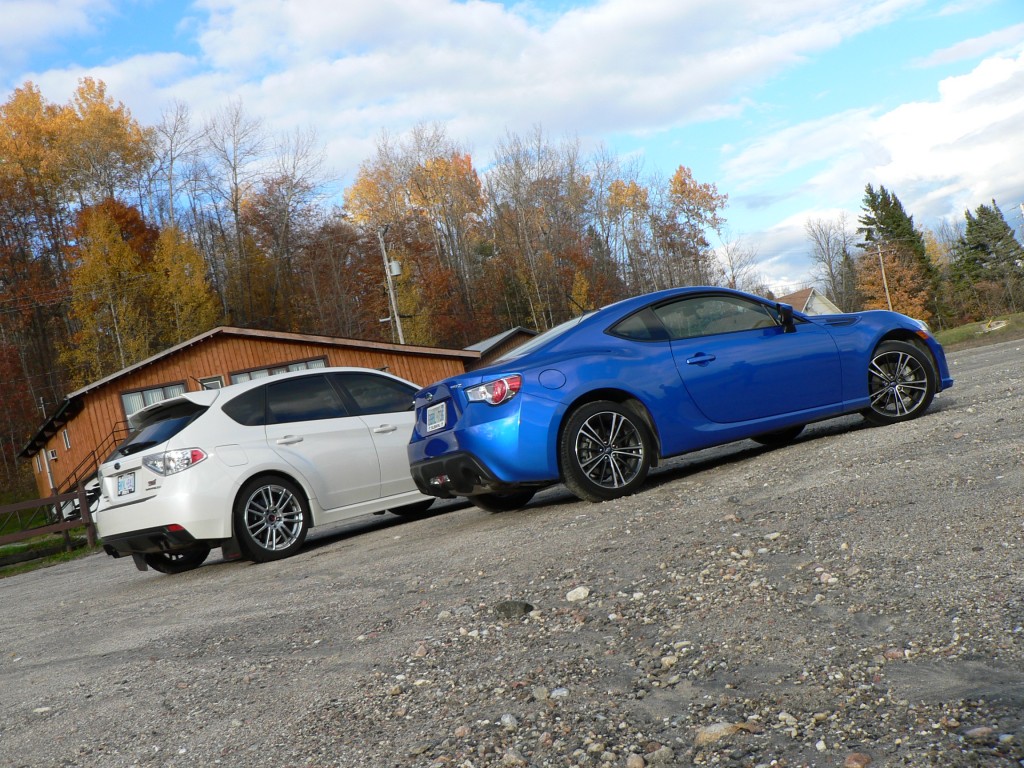 Admittedly, comparing a $40,000 rally-bred hatch to an entry-level $27,000 sports coupe is a case of apples and oranges – we knew that from the outset. But how does confirmed Subaru junkie Stacey feel the BRZ fit into the Subaru family?
“I think the BRZ’s gearbox is sharper and its seats are better. And I liked the low-slung driving position. It very much reminds me of my 1983 Mazda RX-7. It’s very minimalist, and a lots of fun to drive. But the chassis begs for more engine.”
The bottom-line for our Subaru fan? “There is no way I’d trade my WRX STI for the BRZ. Even as a track car. My car has way more grunt, and is way more solid. It’s a Japanese car, for sure. But it’s not a Subaru.”
Admittedly, comparing a $40,000 rally-bred hatch to an entry-level $27,000 sports coupe is a case of apples and oranges – we knew that from the outset. But how does confirmed Subaru junkie Stacey feel the BRZ fit into the Subaru family?
“I think the BRZ’s gearbox is sharper and its seats are better. And I liked the low-slung driving position. It very much reminds me of my 1983 Mazda RX-7. It’s very minimalist, and a lots of fun to drive. But the chassis begs for more engine.”
The bottom-line for our Subaru fan? “There is no way I’d trade my WRX STI for the BRZ. Even as a track car. My car has way more grunt, and is way more solid. It’s a Japanese car, for sure. But it’s not a Subaru.”
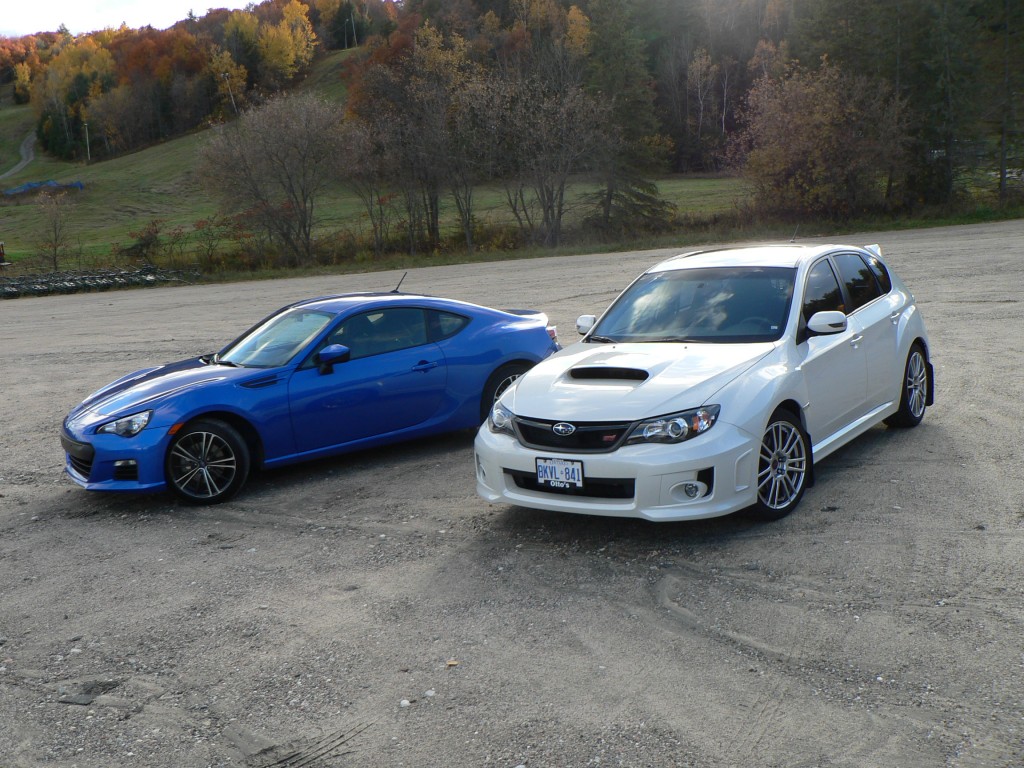
Comments
One Response to “Comparo: 2013 Subaru BRZ versus 2011 Subaru WRX STI”





October 22nd, 2013 @ 8:42 am
[…] doubt kick started by the success of Toyota’s Scion FRS/Subaru BRZ sports cars, rival Japanese automaker Nissan will debut a pair of sports car concepts at next […]